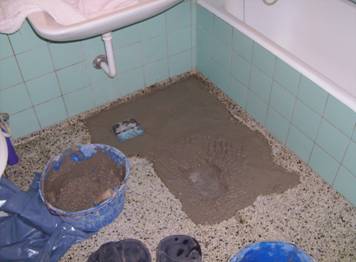

Repair of terrazzo floors
1920-1960
The invisible repair of a terrazzo floor is difficult to achieve because the colour of the cement paste changes over time due to the effects of light, wear and soiling, etc. If the stone composition is unknown prior to the repair, a count is carried out on an area measuring e.g. 100 x 100 mm and a calculation made to determine the cutting size and type and the colour of the stones in the mix. The preparatory work does not give an unequivocal mixing formula, but a reasonable result can be obtained through repeated test mixes, a little luck and a good deal of experience.
The repair site is cut out to the correct geometric shape and finished with a 90-degree edge to a depth of at least 10 mm. When using diamond cutting, the edges of the repair site must be roughened afterwards. It then receives a thorough vacuuming. The absorption capacity of the concrete bed is assessed with regards to the extent of prewashing. If a vertical or downward facing cut-out does not contain reinforcement, mechanical anchorage of the repair mortar should be incorporated.
The repair mortar is adapted to the actual repair model and/or laying method. Depending on whether the laying is done using formwork or modelling, the chosen repair mortar will have a grading curve capable of achieving a good degree of compactness using the modelling method in question. The grading curve should be based on the largest possible grain size, up to a maximum of one third of the coating thickness.
Further information is available from BYG-ERFA, etc.: Wet rooms
Photos: KM Terrazzo & Partner